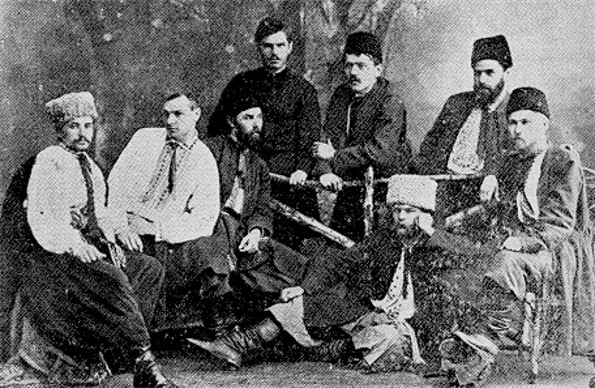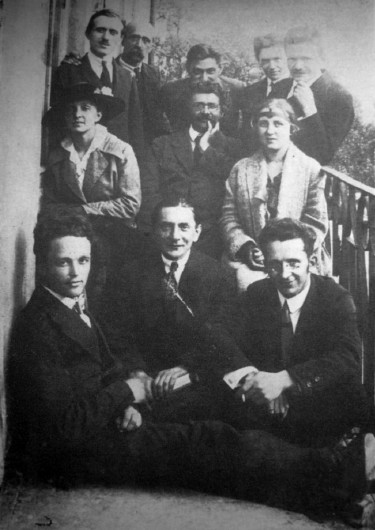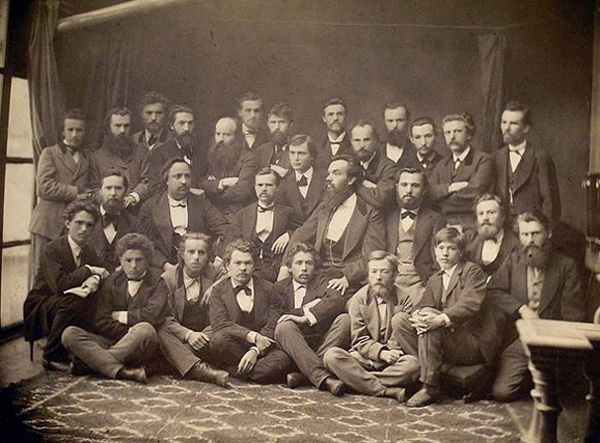Intelligentsia
Intelligentsia (інтеліґенція). A collective name for those who play a leading role in the cultural, social, and intellectual life in a society, from the Latin word intelligentia (‘intelligence’) from intellegere (‘to perceive, understand, comprehend’). In Ukrainian and Russian the term (inteligentsiia, intelligentsiia) is a general abstract noun based on the noun inteligent, intelligent (‘intellectual’). Contemporary sociological usage, however, often distinguishes between the intelligentsia—a broad social group consisting of professionally trained specialists—and intellectuals—a subcategory of the former that includes only those who serve as culture-bearers and the custodians of the tradition of creative and critical thinking about society’s problems.
The word ‘intelligentsia’ is widely thought to be of mid-19th-century Russian origin, when it referred to a small educated minority whose members came from all sections of society, but mainly from the nobility and urban bourgeoisie (burghers). During the 19th century the term was also often used to describe only those educated individuals who aspired to independent thinking, questioned traditional values and the status quo, and sought radical social and political changes (eg, the Slavophiles and Westernizers, and later the populists, socialists [see Socialism], and Marxists [see Marxism]).
In Soviet Ukraine the intelligentsia was defined as ‘a social group comprising individuals professionally involved in creative mental work, in the development and dissemination of culture, or in fulfilling specific administrative functions in production or other spheres of social life.’ This broad definition included almost all individuals employed in occupations requiring some post-secondary education, ie, professional scientists, engineers, teachers, physicians, librarians, academics, writers, artists, and supervisory personnel in industry and the state administration. Unlike the workers and collective farmers, who were said to constitute a class (see also Working class), the intelligentsia was considered to be a social group. However, some Western analysts and unofficial Soviet theorists argued that part of the intelligentsia—ie, those in the political, military, and police hierarchy—did, in fact, constitute a new ruling class.
In modern times the intelligentsia has played a prominent role in anticolonial and national movements, particularly of nations that have lost their traditional ruling class (eg, the nobility) and whose economic development has been so weak that it has failed to produce significant indigenous bourgeois, petit-bourgeois, merchant, or artisan groups. In other national movements the petite bourgeoisie (eg, the Czech) or the gentry (eg, the Polish or Hungarian) played a leadership role, but in Ukraine leadership of the national movement went by default to the intelligentsia, because the other groups were missing in the social structure of the Ukrainian nation. The fact that until recently the Ukrainian intelligentsia was a small group hindered the development of national consciousness and the national movement.
The intelligentsia emerged as a separate social stratum in Russian-ruled Ukraine in the first half of the 19th century. Its ranks were initially filled by the sons of the minor gentry, who, finding no outlet in agriculture and commerce, sought positions in the service of the empire as petty officials and clerks, junior military and naval officers, or educators. Every modest modernizing step, eg, the growth of industry or the educational system, increased the size of the indigenous intelligentsia. The emancipation of the peasantry in 1861, which hastened its differentiation, provided an additional stimulus for the growth of its cadres. In the 1870s, the richer peasants, like their gentry predecessors, began pushing their sons to acquire some education.
Because of the preponderance of impoverished peasants in Ukraine’s social structure and an educational system that was elitist and linguistically Russian, the nationally conscious Ukrainian intelligentsia represented but a tiny layer of the population. According to the 1897 census, out of a total population of 23.4 million in the nine Ukrainian gubernias, only 24,000 individuals had some form of tertiary education, and only 17,000 had specialized secondary education. The vast majority of this intelligentsia was not Ukrainian, but Russian, Jewish, or Polish. Moreover, because of socioeconomic and political pressures, many members of the intelligentsia with Ukrainian backgrounds had become Russified. For example, only 16 percent of the lawyers, less than a quarter of the teachers, and only 10 percent of the writers and artists in Ukraine claimed Ukrainian nationality in 1897. Of the 127,000 people enumerated in the census as having occupations involving intellectual labor, less than a third were Ukrainian.
The first formal sociopolitical organization of the nationally conscious Ukrainian intelligentsia—the secret Cyril and Methodius Brotherhood—existed briefly (1846–7) before being suppressed. From the late 1850s to the 1890s, the clandestine hromadas were its main organizations. In the late 19th century, the Ukrainian intelligentsia turned to organizing Prosvita societies, a co-operative movement, and revolutionary political parties. From the Revolution of 1917 to 1921 the national movement and the struggle for Ukrainian autonomy and then struggle for independence (1917–20) were headed largely by the intelligentsia.
In Western Ukraine the emergence of an intelligentsia was the result of the educational reforms of the Habsburg enlightened absolutists Maria Theresa (1740–80) and her coruler and successor Joseph II (1765–90). They established theological seminaries in Vienna (Barbareum), Lviv (the Greek Catholic Theological Seminary in Lviv), Uzhhorod, and Chernivtsi to provide the Ukrainian clergy with a higher education; they also founded Lviv University and gymnasiums in Lviv (the Academic Gymnasium of Lviv) and Uzhhorod (see Uzhhorod gymnasium) (a gymnasium was founded in Chernivtsi in 1808). In both Galicia and Transcarpathia these institutions very rapidly produced a Ukrainian intelligentsia. In the case of Transcarpathia there was even an overproduction of intelligentsia relative to the needs of the region, and a number of Ukrainian intellectuals immigrated to the Russian Empire, where they enjoyed considerable success (eg, Petro Lodii, Ivan Orlai, Yurii Venelin, and others). Although this new intelligentsia was primarily clerical, it included a secular component from the start, especially in Transcarpathia; a Ukrainian secular intelligentsia was unambiguously in evidence in Galicia by the 1840s. The development of a Ukrainian intelligentsia proceeded much more slowly in Bukovyna, since the Habsburgs did not take as much care to educate the Orthodox clergy there as they did to educate the Greek Catholic clergy in the rest of Western Ukraine.
During the Revolution of 1848–9 in the Habsburg monarchy it was primarily the Galician clergy that assumed leadership of the Supreme Ruthenian Council, the representative political body of Western Ukraine. Nonetheless, the secular intelligentsia (often of clerical social backgrounds) played a considerable role: Ukrainians employed in the civil service made up 32 percent of the council’s membership; university and gymnasium students, 10 percent; and educators and writers, each 5 percent.
The constitutional restructuring of the Austrian Empire in the late 1860s had a major impact on the west-Ukrainian intelligentsia. The Compromise of 1867 between Austria and Hungary (see Austria-Hungary) led to the forcible Magyarization of the church, bureaucracy, and educational institutions in Transcarpathia, decimating and weakening the local Ukrainian intelligentsia. In 1910 only 0.8 percent of Transcarpathia’s Ukrainians were employed as teachers, notaries, lawyers, priests, journalists, or in the military.
Although the Ukrainian intelligentsia in Galicia was subject to pressures of Polonization after the Austro-Hungarian Compromise, these pressures were more than counterbalanced by the civil rights guaranteed under the Austrian constitution of 1867. As in Transcarpathia, only 0.7 to 0.8 percent of the Ukrainian population was employed in the bureaucracy and liberal professions in 1900, yet there were several crucial differences. First, the Galician Ukrainian intelligentsia achieved a relatively high aggregate number (over 6,000 by the early 1870s, and over 20,000 by the turn of the century), which enabled it to undertake ambitious projects (such as the establishment of an academy—the Shevchenko Scientific Society—in 1893 and the publication of 43 periodicals, including several daily newspapers, by 1910). Second, as a result of the liberties constitutionally guaranteed in Austria but absent in the Russian Empire and Hungary, members of the intelligentsia were able to work almost exclusively in the Ukrainian language, whether as clergymen, journalists, lawyers, or professors. Thus, although the Galician intelligentsia was smaller in absolute numbers than the Ukrainian intelligentsia in the Russian Empire and roughly equal in proportionate size to the Transcarpathian, it had a freedom of national intellectual action that made a significant qualitative difference. Finally, unlike its counterpart in Russian-ruled Ukraine and Transcarpathia, it had the opportunity to link up with the masses of the Ukrainian population, the peasantry, in a well-organized national movement. The intelligentsia discovered very early on that the leadership of a mass national movement produced tangible benefits for itself, such as the expansion of the Ukrainian-language educational system at all levels and entrance into government and parliamentary careers for its members. It established manifold institutions to link up with the masses, the first and most important of which was the popular educational Prosvita society (during the first seven years of its existence, 1868–74, Prosvita had a membership consisting primarily of clergy [33 percent], lawyers and civil servants [25 percent], educators [20 percent], and students [10 percent]). The connections forged between the intelligentsia and the peasantry during the half-century preceding the Revolution of 1917 made the revolutionary movement in Galicia more disciplined and unified than that in Russian-ruled Ukraine.
The growth of a Ukrainian intelligentsia in Bukovyna was a phenomenon of the late 19th and early 20th centuries. Key moments in its development were the establishment of Chernivtsi University in 1875 (a quarter of its students were Ukrainian in 1914) and the rapid expansion of the elementary schools system in the early 20th century. The emerging Bukovynian intelligentsia worked very closely with its Galician counterpart, many of whose methods and institutions it copied.
In the wake of the defeat of the Ukrainian national forces in the Ukrainian-Soviet War, 1917–21, many members of the Ukrainian intelligentsia immigrated to Poland, Czechoslovakia, Germany, and France. Those who remained in Soviet Ukraine had their activity and employment opportunities circumscribed by the Bolshevik authorities. After the New Economic Policy and the introduction of Ukrainization in the 1920s, the Bolsheviks were forced to pursue a policy of detente with the Ukrainian intelligentsia. Remaining suspicious of it, the Bolsheviks were nonetheless forced to enlist its support to hasten the economic, social, and educational development of the republic. During the relatively liberal period of 1923–9 the Ukrainian intelligentsia seized whatever opportunities were available and spearheaded the cultural and national renaissance of that period.
The growth of the state apparat, the Ukrainization of public institutions, and the expansion of the educational system greatly contributed towards expanding the size of the indigenous intelligentsia. Thus the number of employees in the educational system grew from 70,131 in 1926 to 111,135 in 1929, and the percentage of Ukrainians in it increased from 65 to 72. Between 1926 and 1929 the number of individuals engaged in other forms of intellectual work expanded from 255,223 in 1926 to 397,701 in 1929, and the representation of Ukrainians from 52 to 58 percent. In 1923 only 23 percent of civil servants in the republic were Ukrainian, but by 1926 the figure had risen to 54 percent.
In 1928, as Ukrainization was drawing to a close with the rise of Stalinist totalitarianism, the intelligentsia received its first major blow with the show trial of ‘bourgeois specialists’ (see Shakhty Trial) in the Shakhty region. This was followed by arrests and the show trial of members of the intelligentsia accused of belonging to a so-called Union for the Liberation of Ukraine (SVU). The purpose of these campaigns was to intimidate and silence the members of the intelligentsia who had led the intellectual, cultural, and national revival of the 1920s.
During the Soviet industrialization drive of the 1930s the intelligentsia of Ukraine, especially technical personnel, experienced rapid growth. Thus, the number of engineers and technical staff increased from 25,000 in 1926 to 123,000 in 1936. The majority of the members of this new scientific and technical intelligentsia were former workers and peasants who had been given an education and promoted to positions of responsibility. Very little information on changes in the national composition of the intelligentsia during the 1930s has come to light. Data that are available suggest that although in absolute numbers Ukrainians registered an increase, their percentage in the intelligentsia remained static or declined. A comparison of 1929 and 1939 data shows that the Ukrainians’ share of intellectual occupations declined from 58 percent to 56 percent.
The Stalinist terror of the 1930s took a heavy toll of the Ukrainian intelligentsia. It is estimated that 80 percent of Ukraine’s writers and creative intelligentsia were eliminated. As a result of the 1933–4 purge, for instance, the proportion of Ukrainians among the staff of research institutes in Soviet Ukraine dropped from 50 percent of the total in 1929 to 31 percent in 1934, whereas the share of Russians increased from 30 to 50 percent in the same period.
In the interwar period the situations of the Ukrainian intelligentsia in the three regions of Western Ukraine were almost the reverse of what they had been in the late 19th and early 20th centuries. Now the development of the intelligentsia was retarded in both Galicia and Bukovyna, while in Transcarpathia a Ukrainian intelligentsia flourished. In both Poland and Romania, to which Galicia and Bukovyna were annexed after the defeat of the Ukrainian national revolution, chauvinistic government policies excluded Ukrainians from employment in the civil service, discriminated against them at all educational levels (but particularly at the university level), drastically reduced or abolished state subsidies for Ukrainian intellectual and cultural institutions, and reduced the status of the Ukrainian language. As a result of these policies, exacerbated later by the effects of the Depression, most of the Ukrainian intelligentsia found its talents underutilized. Outstanding scholars ended up teaching in secondary schools or made ends meet by writing for the popular press. Many ambitious young intellectuals were fortunate to find employment as bookkeepers with the co-operative movement. This frustration of the Ukrainian intelligentsia in interwar Galicia and Bukovyna was a prime factor inclining it to political extremism in the 1930s.
By contrast, the situation in Transcarpathia was quite favorable. The new Czechoslovak regime expanded the educational system dramatically, deliberately recruited Ukrainians to the lower levels of the civil service, and did not discriminate against the Ukrainian language. Thus, by 1930 in Transcarpathia 13,670 Ukrainians (2.5 percent of the total Ukrainian population) were employed in the bureaucracy and liberal professions.
During the Second World War, many members of the Soviet Ukrainian intelligentsia were evacuated to Central Asia in the face of the advancing German army. The Nazis unleashed a wave of terror against the remaining intelligentsia, in keeping with Heinrich Himmler’s orders that ‘the entire Ukrainian intelligentsia must be decimated ... Do away with it and the leaderless mass would become obedient.’
In the postwar period, the demands of scientific and technological development necessitated the rapid numerical growth of the intelligentsia. Thus, the gainfully employed intelligentsia in Soviet Ukraine grew from 513,000 in 1941 to 3,269,000 in 1970 and 5,958,000 in 1983. (The totals for the USSR were 2,401,000, 16,841,000, and 31,628,000 in the respective years.) Included in these figures were individuals who only completed secondary special education (3,430,000 in Ukraine and 18,141,000 in the USSR in 1983). Some sociologists argue that, properly speaking, the intelligentsia consisted only of persons with a higher education (tertiary education). Using this criterion, the gainfully employed intelligentsia in 1983 numbered 13,487,000 in the USSR and 2,528,000 in the Ukrainian SSR (53 percent of it women). In Ukraine engineers were the single largest group within the intelligentsia with tertiary educations—1,085,000 in 1983.
It is possible to ascertain the Ukrainians’ share of the intelligentsia as a whole (those gainfully employed, students, and pensioners) for 1970: the 1.1 million Ukrainians who belonged to the intelligentsia (with tertiary educations) represented 54.7 percent of the total group in the republic. In the case of the intelligentsia as a whole (including those with secondary special education), 63.1 percent, or 2.6 million, were Ukrainian. Data on the national composition of specialists—defined as all those with higher education or secondary special education gainfully employed in the national economy—show that the Ukrainians’ share in this occupational group dropped slightly, from 63.5 percent in 1960 to 63.2 percent in 1970. Since in 1970 Ukrainians represented 75 percent of the republic’s total population, these figures indicate a serious underrepresentation of Ukrainians in the intelligentsia of Soviet Ukraine. This problem was itself tied to difficulties in the social mobility of Ukrainians.
In the late Soviet period the intelligentsia remained the most active element in society promoting Ukrainian national demands. Indicative of this was the fact that the large majority of dissidents in Soviet Ukraine were members of the intelligentsia.
BIBLIOGRAPHY
Leikina-Svirskaia, V. Intelligentsiia v Rossii vo vtoroi polovine XIX veka (Moscow 1971)
Churchward, L.G. The Soviet Intelligentsia: An Essay on the Social Structure and Roles of Soviet Intellectuals during the 1960s (London and Boston 1973)
Bailes, K.E. Technology and Society under Lenin and Stalin: Origins of the Soviet Technical Intelligentsia, 1917–1941 (Princeton 1978)
Magocsi, P.R. The Shaping of a National Identity: Subcarpathian Rus', 1848–1948 (Cambridge, Mass and London 1978)
Krawchenko, B. Social Change and National Consciousness in Twentieth-Century Ukraine (London 1985)
Tkachova, L. Intelihentsiia Radians'koï Ukraïny v period pobudovy osnov sotsializmu (Kyiv 1985)
Kozik, J. The Ukrainian National Movement in Galicia: 1815–1849, ed L.D. Orton (Edmonton 1986)
Kurnosov, Iu. Inakomyslennia v Ukraïni (60-ti–persha polovyna 80-kh rr. XX st.) (Kyiv 1994)
Kurnosov, Iu. (ed). Narysy istoriï ukraïns'koï intelihentsiï (persha polovyna XX st.), 3 vols (Kyiv 1994)
Kasianov, H. Nezhodni: Ukraïns'ka intelihentsiia v rusi oporu 1960–80-kh rokiv (Kyiv 1995)
Lindheim, R.; Luckyj, G. (eds). Towards an Intellectual History of Ukraine: An Anthology of Ukrainian Thought from 1710 to 1995 (Toronto 1996)
John-Paul Himka, Bohdan Krawchenko
[This article originally appeared in the Encyclopedia of Ukraine, vol. 2 (1988).]
.jpg)

.jpg)

